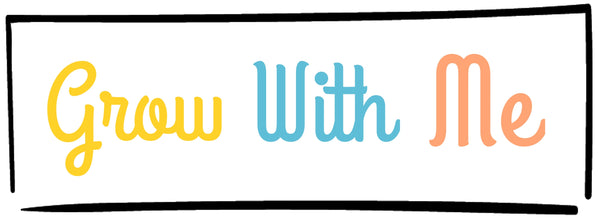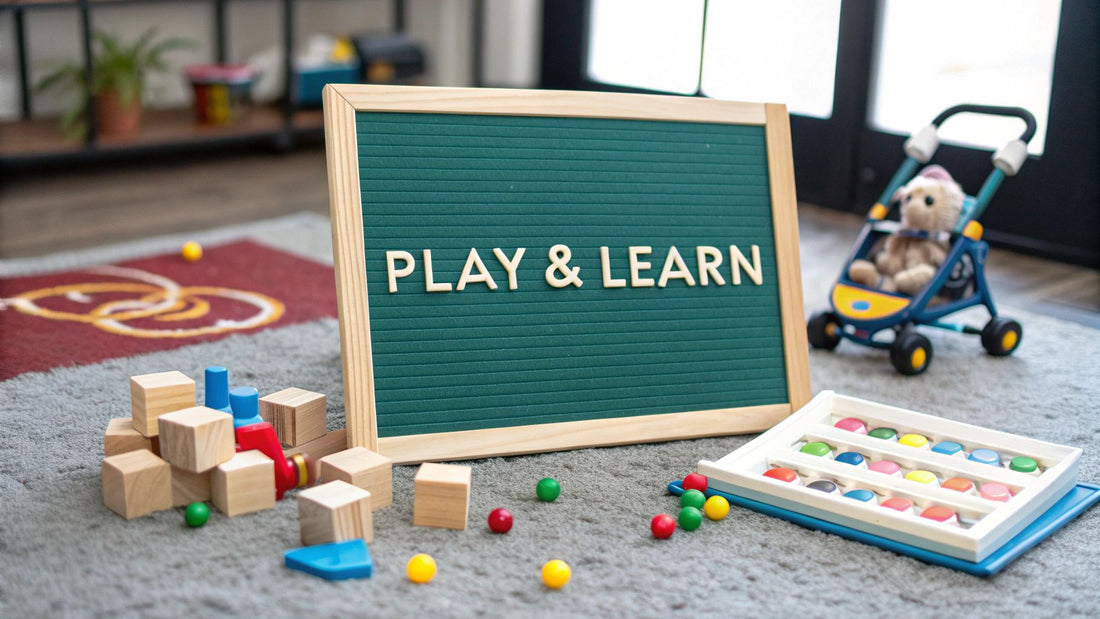
Best Learning Toys for 1 Year Olds A Parent's Guide
Share
When you're looking for the best learning toys for a 1-year-old, you're really looking for tools that click with their explosive developmental growth. Think about toys that target their motor skills, spark cognitive connections, and engage their senses. The absolute winners in this category are often classics like stacking rings for fine motor control, shape sorters for early problem-solving, and simple board books to kick-start a love for language.
Matching Toys to Your One-Year-Old’s Milestones
That first birthday is such a massive moment. It marks the shift from a mostly stationary baby into a wobbly, curious toddler who's desperate to get up and explore their world. This year is just packed with incredible firsts – those first tentative steps, the first real words, and that dawning realisation of how things fit together.
At this age, play is literally their most important job, and the right toys are the tools of their trade. A set of chunky wooden blocks isn't just a toy; it's a hands-on lesson in gravity, balance, and cause-and-effect. A colourful stacking toy is a masterclass in hand-eye coordination and spatial reasoning. Choosing the best learning toys for a 1-year-old isn't about finding the flashiest entertainment, but about purposefully fuelling their development.
This infographic breaks down the core benefits of developmental toys into three main pillars.
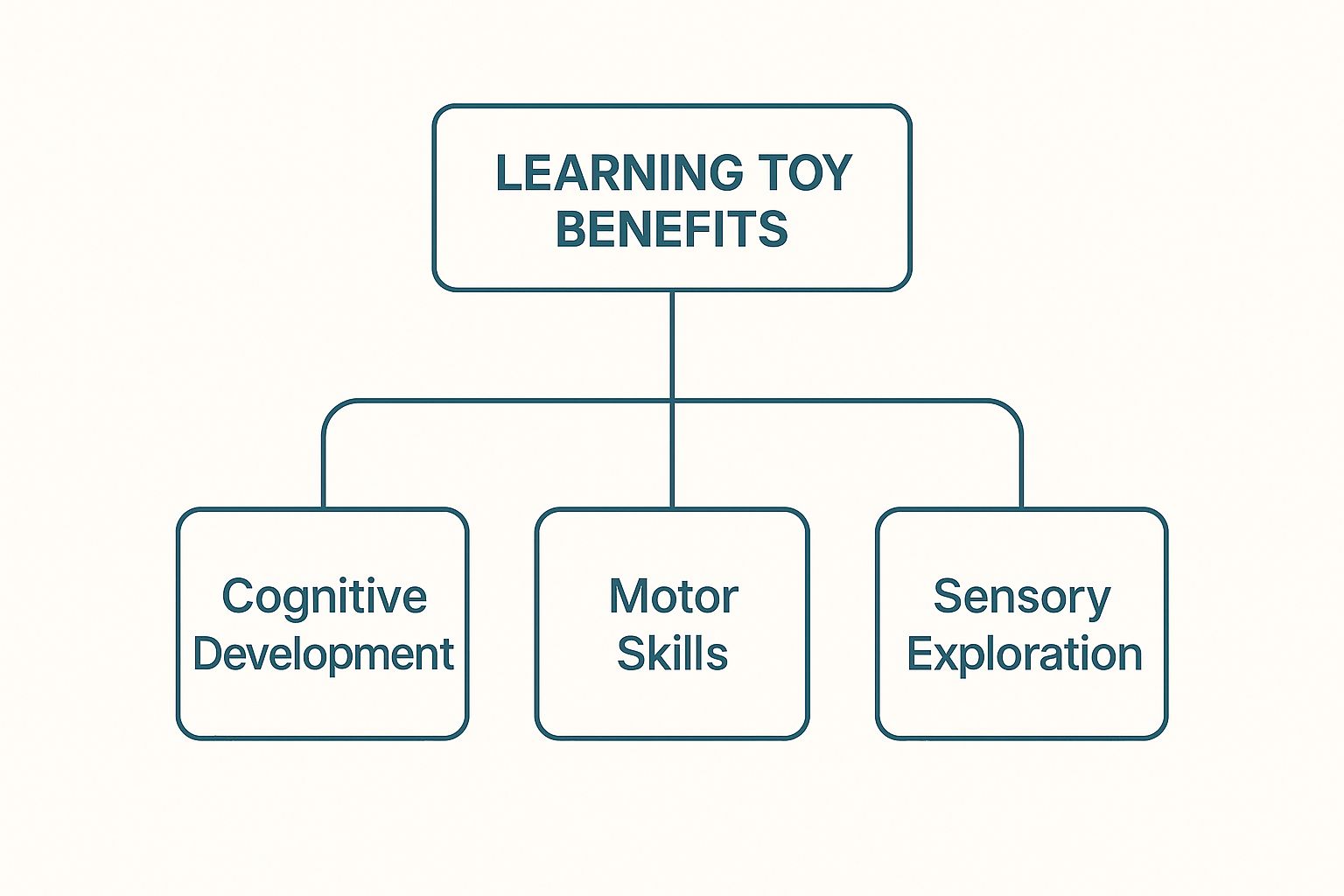
As you can see, a single brilliant toy can support cognitive skills, motor development, and sensory input all at once. Grasping this connection is the first step toward building a powerful toy collection that genuinely nurtures your child’s growth.
Why Milestones Matter
Right around their first birthday, your toddler is working on a huge range of new skills. They're refining their clumsy grasp into a delicate pincer grasp, which lets them pick up smaller items with their thumb and forefinger. They are also starting to understand object permanence – the big idea that things still exist even when they can't see them. Peek-a-boo is suddenly the best game ever for a reason!
A well-chosen toy meets a child where they are developmentally but also offers a gentle nudge toward the next milestone. It should be challenging enough to be engaging but not so difficult that it causes frustration.
This is exactly why a toy that captivated them at nine months might be completely ignored now, while a more complex one is still too advanced. The secret is finding that developmental sweet spot. For instance, a simple puzzle with big, chunky, knobbed pieces is perfect for little hands still mastering their grip. It directly supports their current fine motor skills while introducing the very first steps of problem-solving.
To help you see these connections more clearly, here’s a quick guide matching developmental areas to the kinds of toys that help them flourish.
Developmental Milestones and Corresponding Toy Types
| Developmental Area | Skills Being Learned | Recommended Toy Category |
|---|---|---|
| Fine Motor Skills | Pincer grasp, hand-eye coordination, wrist rotation | Stacking toys, shape sorters, large puzzles with knobs |
| Gross Motor Skills | Walking, balancing, climbing, pulling up | Push walkers, ride-on toys, soft play blocks |
| Cognitive Growth | Object permanence, problem-solving, cause and effect | Nesting cups, simple puzzles, lift-the-flap books |
| Language & Social | First words, understanding simple commands, imitation | Board books, baby dolls, toy telephones |
| Sensory Exploration | Exploring textures, sounds, and colours | Sensory balls, musical instruments, textured board books |
This table is just a starting point, but it shows how different types of play support specific areas of growth. As you explore your options, it's helpful to understand the different developmental needs of toddlers, which is why we created a guide on the best toys for 1 and 2-year-olds to highlight these distinctions.
By aligning toys with these specific developmental windows, you make sure playtime is not just fun, but also incredibly productive. You're giving them the exact tools they need to practise new skills, build confidence, and satisfy that powerful, natural curiosity to learn and discover.
The UK's Growing Focus on Educational Play
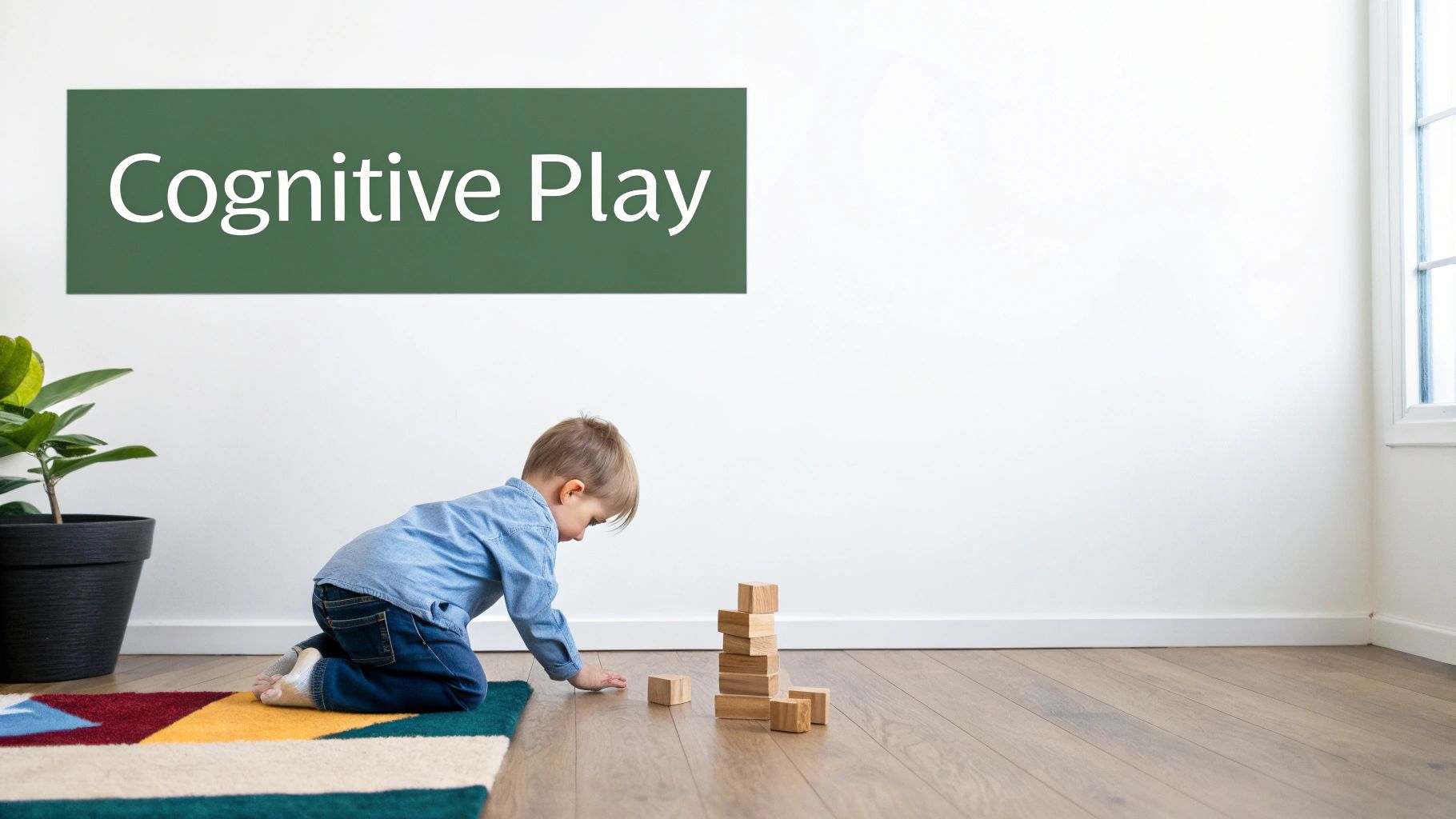
If you’ve browsed a toy shop recently, you've probably noticed a real change. It seems like every box is stamped with words like “developmental,” “educational,” or “skill-building.” This isn’t just a marketing gimmick; it’s a reflection of how parents across the UK are thinking differently about playtime.
There’s a growing understanding that play is more than just fun—it’s fundamental to how a child learns about the world. Parents are now actively looking for toys that entertain and educate, helping to build crucial cognitive, motor, and sensory skills right from the start.
This demand for more meaningful play is completely reshaping the toy industry. We're moving away from passive, press-a-button-and-watch toys towards those that invite a child to explore, problem-solve, and imagine. Choosing the best learning toys for a 1 year old has become less of a trend and more of a conscious decision to support a child’s early growth.
The Numbers Behind the Trend
This shift isn't just a feeling; the numbers back it up. The UK's toy market is now valued at around £11.5 billion, and a huge part of its growth is being driven by parents investing in educational products. As our understanding of early childhood development deepens, so does the demand for toys that can teach. You can find more detailed insights on UK toy market trends over on expertmarketresearch.com.
What this really shows is that parents are voting with their wallets. They are choosing to spend their money on toys that offer genuine developmental benefits, making it clear that educational value is now a top priority.
The modern parent isn't just buying a toy; they are investing in a learning experience. They see a set of wooden blocks not just as pieces of wood, but as the building blocks for creativity, spatial awareness, and early physics lessons.
Purposeful Play in Practice
So, what does this actually look like at home on the playroom floor? It’s all about choosing toys that are versatile and can grow with your child. Take a simple set of nesting cups, for example.
For a young one-year-old, those cups are perfect for:
- Grasping and Mouthing: Exploring different textures and shapes in a safe way.
- Banging Together: A brilliant first lesson in cause and effect.
- Stacking and Toppling: Learning the basics of balance and gravity (and that knocking things down is great fun!).
A few months later, that very same set of cups can teach them about size, order, and even volume during bath time. This is the heart of open-ended, educational play. It's also why curated, stage-based toys are becoming so popular. A toy subscription box for kids can take the guesswork out of finding the right toys at the right time, ensuring that playtime is always engaging and perfectly matched to your child’s developing mind.
What Separates a Good Toy from a Great Learning Tool?
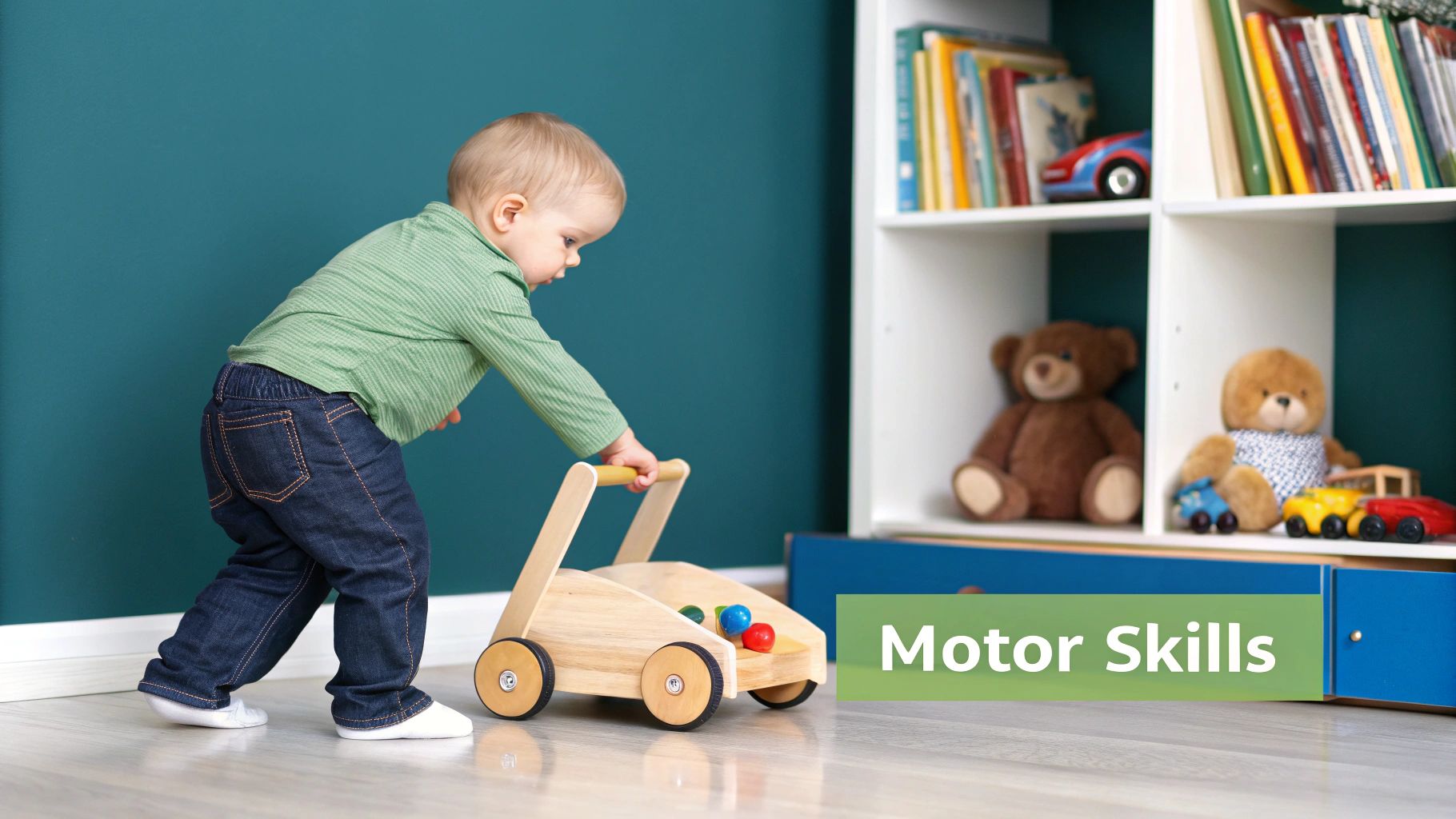
Wandering down the toy aisle, it's easy to get overwhelmed. Not every brightly coloured plastic thing is going to be a powerhouse for your child's development. While many toys are designed for a few minutes of distraction, the best learning toys for a 1 year old have a much deeper purpose.
To find these gems, we need to look beyond the flashy packaging and focus on what really matters. It all starts with the basics.
First up, and most importantly, is safety. At one year old, the mouth is a primary tool for exploration. Everything ends up there! This means toys must be made from non-toxic materials, be too big to pose a choking hazard, and have no small parts that could break off.
Durability is a close second. Let's be honest, one-year-olds aren't exactly gentle. A great learning toy is one that can handle being dropped, thrown, and yes, chewed on, without falling apart.
The Power of Open-Ended Play
Here’s the real secret: the difference between a good toy and a truly great one often comes down to its capacity for open-ended play.
Think of it this way. A toy with a single button that plays one song is a closed-ended toy. It has one function, and once the child has pressed it, the interaction is over. It’s a very passive experience.
An open-ended toy, on the other hand, is like a blank page waiting for a story. A simple set of wooden blocks can be a tower, a castle, a fence for toy animals, or a colourful pattern on the floor. It doesn't dictate how to play; it invites your little one to imagine, create, and figure things out on their own.
This kind of play is the bedrock for developing essential life skills:
- Imagination: It gives them the freedom to invent their own worlds and stories.
- Problem-Solving: How do I make the tower taller without it falling? Stacking blocks builds real cognitive muscle.
- Creativity: With no single "right way" to play, your child's innovative thinking is free to flourish.
A truly great learning toy doesn't do the work for the child; it empowers the child to do the work. It sparks curiosity and supports their natural drive to figure things out for themselves.
Toys That Evolve and Grow
Finally, the best toys are those that grow with your child. A set of nesting cups might start as something to simply bang together or chew on. A few months down the line, your child will be mastering how to stack them. Later still, they can be used for sorting colours or scooping water during bath time.
This versatility keeps the toy engaging and challenging as your toddler’s abilities develop, giving you far more value in the long run. This is a core idea in many play philosophies, which we explore further in our guide to Montessori toys for toddlers.
By choosing toys that are safe, sturdy, and designed for open-ended play, you’re not just buying a distraction—you’re creating a rich, stimulating environment for learning.
Exploring the Best Categories of Learning Toys
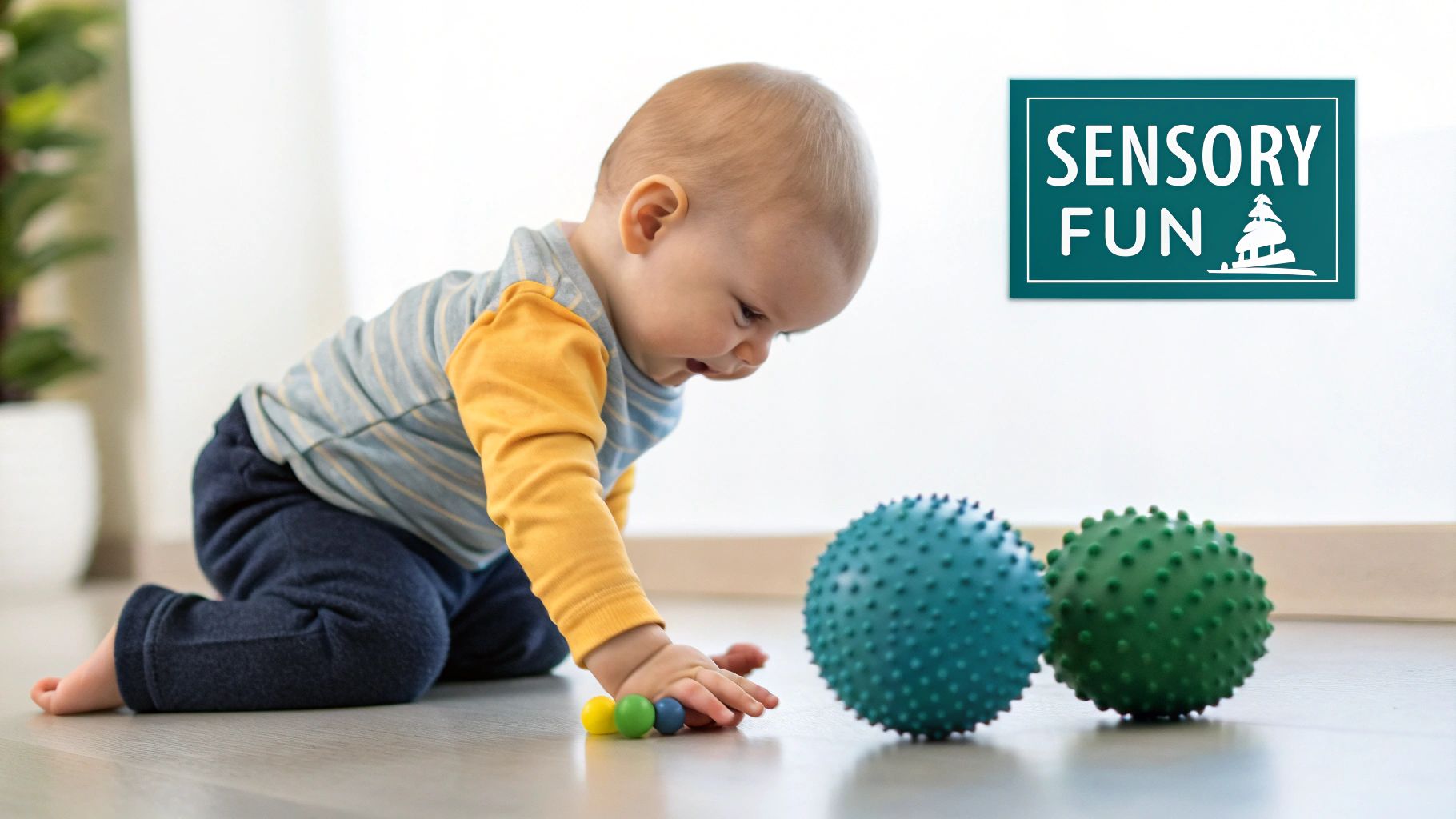
Stepping into the world of toddler toys can feel a bit overwhelming, but you don't need a mountain of plastic to help your little one thrive. The secret is to focus on a few key categories that target crucial, age-appropriate skills. By choosing a small, well-curated collection, you can create a play environment that nurtures every part of their rapidly developing mind and body.
Think of it as putting together a balanced meal for their brain. Each type of toy serves a different purpose, feeding a specific developmental need. This thoughtful approach helps you find the best learning toys for a 1 year old with real intention, making sure their playtime is always packed with purpose.
Toys That Build Dexterity and Coordination
Fine motor skills are all about those small, precise movements in the hands and fingers. At one year old, your child is just graduating from clumsy swats to a more controlled, deliberate grasp. Toys that encourage this refinement are vital for paving the way for future skills, like holding a crayon or figuring out a spoon.
These toys are basically a gym for their tiny hand muscles, building up grip strength and improving hand-eye coordination.
- Stacking Toys: Whether it's classic rings on a post or chunky wooden blocks, stacking is a masterclass in size, balance, and the ever-so-satisfying crash of cause and effect.
- Shape Sorters: These are fantastic first puzzles. They challenge a toddler to twist and turn a shape to make it fit, laying the groundwork for real problem-solving.
- Simple Puzzles: Look for puzzles with big, chunky pieces that have knobs on them. That little knob encourages them to use their pincer grasp—pinching with the thumb and forefinger—which is a huge developmental step.
Toys That Encourage Physical Confidence
While fine motor skills are about the small stuff, gross motor skills are about the big picture—the large muscle groups used for walking, climbing, and keeping their balance. As your one-year-old gets more mobile, toys that support this new freedom are essential for building physical confidence.
The goal of a great gross motor toy isn't just to get them moving, but to help them understand how their body moves through space, building balance and spatial awareness.
Push toys are a perfect example. A solid push walker gives them just enough support as they take those first wobbly steps, building the confidence they need to explore on their own. It’s like a mobile support system that helps turn hesitant shuffles into determined strides.
Sensory and Language Development
At this age, learning is a hands-on, full-body experience. Sensory toys are all about engaging a child's sense of touch, sight, and hearing. Things like textured balls, simple musical instruments, or crinkly fabric books provide a rich stream of sensory information that helps their brain forge new connections.
At the same time, board books are completely non-negotiable for language development. The simple act of sitting together, pointing at pictures, and naming what you see is one of the best ways to build their vocabulary. Plus, turning those sturdy pages is great practice for their fine motor skills. Stick to books with bright, clear pictures and simple, repetitive words.
Recent market research in the UK shows that toys focusing on these skills are exactly what parents are looking for. It's expected that products boosting motor skills will lead market growth, largely because they deliver clear benefits in coordination, problem-solving, and understanding cause-and-effect. You can read more about these toy market findings and see what it means for parents.
Why Eco-Friendly and Sustainable Toys Matter
When you're picking out toys for your one-year-old, it’s easy to focus on what they do. Does it light up? Does it help with motor skills? But what the toy is actually made of is just as crucial. The shift towards eco-friendly and sustainable toys isn't just a trend; it's a reflection of parents wanting what's best for their children's safety and for the planet they'll inherit.
Think about it. Toys made from natural materials like wood, organic cotton, or natural rubber offer a completely different sensory experience. The solid, comforting weight and smooth texture of a wooden block simply can't be replicated by a piece of hollow plastic. This kind of tactile feedback is incredibly important for a one-year-old who is exploring and making sense of their world through touch and, let's be honest, taste.
A Safer Play Environment
That brings us to safety, which is understandably a huge concern for parents. Many of us worry about the chemicals lurking in some plastics, like BPA, phthalates, and PVC. Sustainable toys, on the other hand, are usually finished with non-toxic, water-based paints and natural oils. This gives you peace of mind that when your little one inevitably puts a toy in their mouth, they aren't ingesting anything harmful.
Choosing a well-made wooden or organic toy is a conscious decision to create a cleaner, safer, and healthier play space for your child. It prioritises their immediate well-being while supporting a healthier planet for their future.
This demand for safer, more sustainable products is really making waves in the toy industry. In the UK, the baby toy sector is booming, thanks in large part to this growing parental focus on developmental, eco-friendly options. In fact, projections show the UK baby toys market could hit around £1.3 billion by 2035, growing at 6.10% each year between 2025 and 2035. It just goes to show how much these values are influencing what we buy. You can dig into more data on the UK's growing baby toy market if you're curious.
Durability and Lasting Value
There's another brilliant perk to eco-friendly toys: they are built to last. A solid wooden toy can handle the enthusiastic, often rough, play of a toddler without breaking or cracking. You don't have to worry as much about small, dangerous pieces falling off, which makes them a safer and more cost-effective choice over time.
These classic, timeless toys often become family heirlooms, passed down from one sibling to the next, or even to the next generation. This not only reduces waste but offers far more value than a plastic toy that might be broken and forgotten in a few months. When you choose sustainability, you're investing in quality pieces that enrich your child's development and encourage a more thoughtful way of living.
Got Questions About Toys for Your One-Year-Old? We’ve Got Answers.
When it comes to picking out toys for a one-year-old, it’s completely normal to have a few questions buzzing around your head. As you start to build their first little library of playthings, you might wonder if you’re getting it ‘right’. Am I buying too much? Are those noisy electronic toys any good? Why does everything end up in their mouth?
Let’s clear up some of the most common queries. Think of this less as a strict rulebook and more as a friendly guide to help you feel confident you’re creating a safe, engaging, and genuinely supportive play space for your little explorer.
How Many Toys Does My Toddler Actually Need?
It's one of the biggest myths in parenting: more toys mean more learning. In reality, the opposite is often true. A mountain of toys can easily overwhelm a toddler, causing them to flit from one thing to the next without ever really playing. For a one-year-old, quality will always, always trump quantity.
A well-rounded collection of about 8-10 versatile toys is more than enough. The real magic is in the variety. Aim for a mix that covers all the key developmental bases:
- Fine Motor Skills: Something they can stack, sort, or post, like classic rings or chunky wooden blocks.
- Gross Motor Skills: A toy that gets them moving, like a sturdy push-along walker or a soft ball to roll and chase.
- Sensory & Language: A few interesting textures to explore and a small, sturdy collection of board books.
A simple toy rotation system can be a game-changer. Keep most of their collection stored away and just have a few toys out at a time. Every week or so, swap them for something else. This keeps their play space feeling fresh and exciting, encouraging them to dive deeper into play without the clutter.
Are Electronic Toys Bad for a One-Year-Old?
Those flashy, noisy electronic toys aren't necessarily "bad," but it’s worth thinking about their role in your child's playtime. Most of these toys are what experts call “closed-ended”—they do the work for the child. A button gets pressed, a song plays, and your little one becomes a spectator rather than the star of the show.
The most powerful learning happens with toys that need your child to be the one making things happen. Blocks don't stack themselves, and a puzzle piece won't find its own home. These simple, "passive" toys are what build active, creative, problem-solving minds. If you do have electronic toys, just make sure to balance them with plenty of open-ended options that let your child’s imagination run wild.
Why Does My Child Put Everything in Their Mouth?
Mouthing isn't just a quirky habit—it's a critical part of how they learn. For a one-year-old, their mouth is like a super-powered sensory tool. It’s how they figure out the world around them, exploring texture, shape, and temperature in a way their hands can't quite manage yet.
This is exactly why toy safety is so incredibly important. Every single thing your child can get their hands on needs to be:
- Made from non-toxic materials with safe, water-based paints.
- Far too large to be a choking hazard. A good rule of thumb is that it shouldn’t be able to fit through a toilet paper tube.
- Solidly built, with no small parts that could snap off during an enthusiastic play (or chew) session.
Giving them safe, mouthable toys isn’t just about avoiding accidents; it’s about supporting one of the most fundamental ways they discover their world.
When Should We Introduce Puzzles and Shape Sorters?
Instead of focusing on the age on the box, watch for your child’s own developmental cues. The perfect time to bring out a first puzzle is when you see them getting curious about how things fit together. Are they trying to pop smaller objects into bigger containers? That’s your sign! They’re starting to develop the hand-eye coordination needed to take on the challenge.
Start simple. A puzzle with just one or two big shapes, each with a chunky knob handle, is the perfect entry point. A shape sorter with just a circle and a square hole keeps things from getting frustrating. The goal is to offer a gentle, achievable challenge that boosts their confidence and makes them want to try again. If they get frustrated, don’t worry—just show them how it works and bring it out again in a few weeks.
At Grow With Me, we take the guesswork out of finding the perfect developmental tools for your child. Our curated play kits are designed to match your one-year-old’s milestones, delivering stage-based, eco-friendly toys right to your door.
Explore our age-appropriate play kits today and give your child the tools to learn and grow through the power of play.
